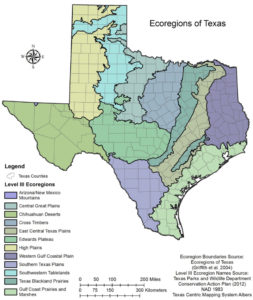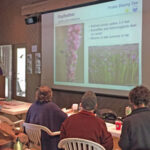Level 1 is a prerequisite for Level 2 and for Level 3. Subsequent levels may be taken in any order.
NLCP is a state-wide program, but classes focus on the characteristics and plants of the region in which they are taught. Please register for classes located in the region in which you wish to landscape.
For more information or to complete a mail-in registration send a request to Linda Foss at Linda.Foss@npsot.org.
Level 1, Introduction to Native Landscapes
- Appreciate the benefits of including and preserving native plants in landscapes and building wildlife habitat.
- Distinguish between sustainable and conventional development.
- Identify your local Texas ecoregion, including soil type.
Level 2, Landscape Design with Native Plants
- Learn to create landscape designs using native plants.
- Recognize important considerations for creating a design.
- Outline steps in the design process; practice creating a native landscape design.
Level 3, Installation and Maintenance of Native Landscapes
- Recognize the differences between native and non-native landscapes.
- Become familiar with how to install the different types of native plants into a landscape, including: plant choice, purchase, placement, spacing; soil choice; bed and soil preparation; planting seeds and plants; mulching.
- Understand maintenance requirements and techniques. Create maintenance schedules for different types of native plants.
Level 4, Stewardship of Native Plant Communities
- What land stewardship is and why it matters
- Application of stewardship, from urban neighborhoods to large-scale natural areas.
- Threats to natural habitats and resulting impacts
- How to create an effective land stewardship plan, including:
Researching and assessing what you have,
Setting and prioritizing your goals,
Prioritizing and implementing appropriate land management practices, and
Monitoring and re-assesing the effectiveness of your land stewardship

Certificates of Competency
You have the option of taking a test in order to earn a Certificate of Competency for Levels 1 – 4. Select this option if 1) you want to highlight your participation in the program on your business card or resume 2) earn CEUs, or 3) qualify as a NLCP instructor. Tests are open book and generally 40 questions long. You will not need to know all 50 plants, but some familiarity is important. About half the questions will cover plant identification. You will see plants in a slide presentation, on a plant walk, and on display in the classroom. You will also have a detailed plant list to review as you take the test. Most students pass, but if you wish, you are welcome to skip the test.
No certificate is issued if you elect not to take the class. But provided you complete all portions of Level 1, you will be allowed to continue with the other classes.
Companion Class – Native Landscapes for Birds
- Appreciate the rich bird diversity in Texas and their contributions to the natural world.
- Understand current threats to bird populations and what you can do to help.
- Recognize the importance of native plants and plant diversity to the success of birds.
- Create and maintain bird friendly native plant landscapes.
- This class has no pre-requisite, no test and no certificate.

